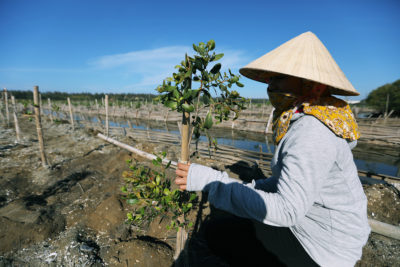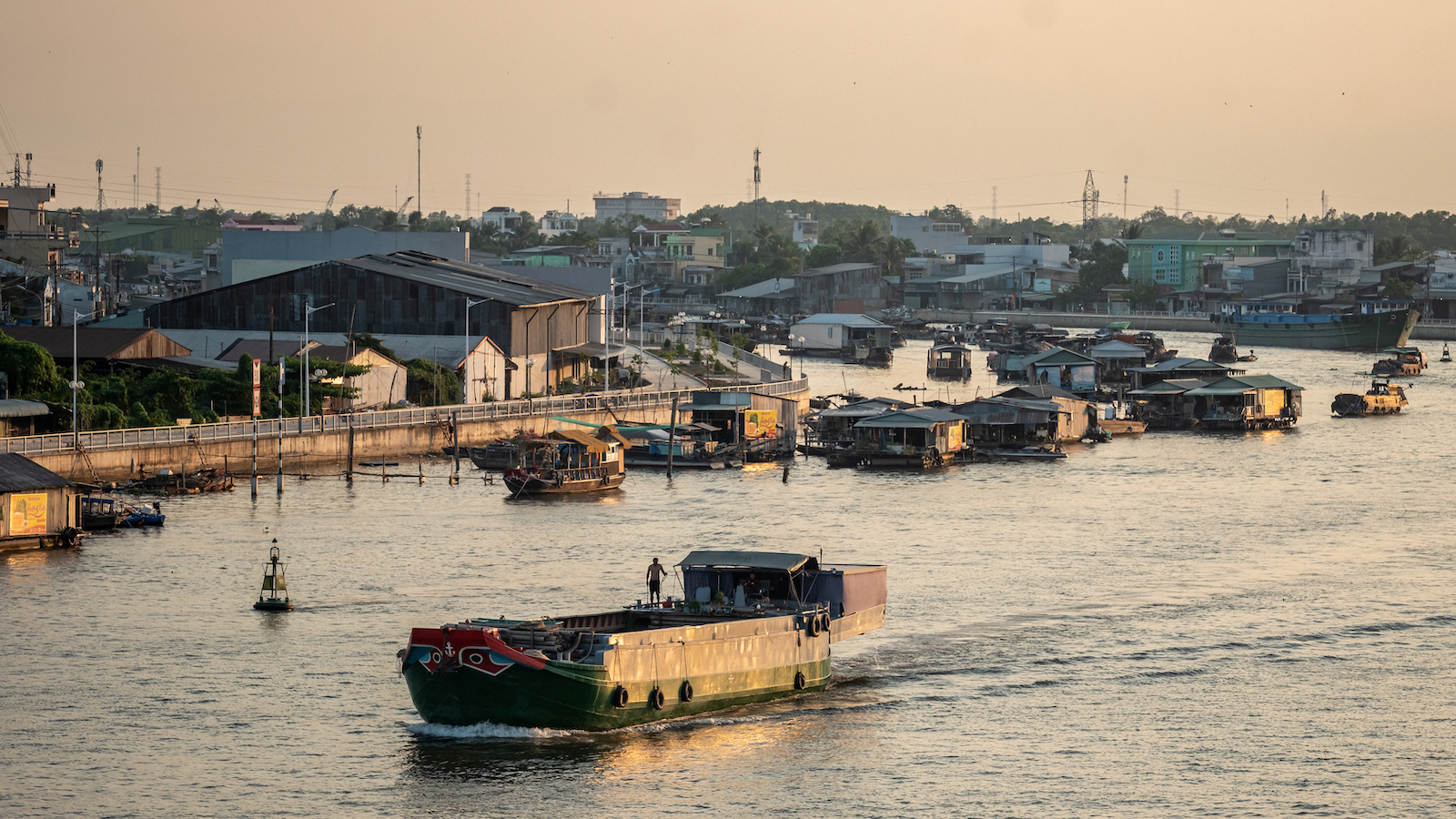We depart from Can Tho, the bustling coronary heart of Vietnam’s Mekong River delta, earlier than dawn, heading south to an aquaculture farm in coastal Cà Mau province. The farm, I’m advised, showcases how farmers within the delta are preserving scarce freshwater through the intensely scorching dry season.
A drive of a number of hours takes us by what is called the nation’s “rice bowl” and its aquaculture epicenter. Most hanging to a customer is how practically each inch of land right here is cultivated or constructed upon. Houses abut shrimp farms, and employees load Melaleuca tree trunks onto vehicles. Slim roads parallel a crisscross of canals constructed for irrigation and transportation.
However all is much from effectively in what, at first look, seems like an agricultural paradise. Many of the waterways are dried out, their mud bottoms uncovered and cracked. This isn’t uncommon within the dry season, however these fissures have grown extra seen with every passing yr, symbolizing the deepening fractures stressing this area, which is residence to twenty million folks.
Sand mining within the river and the blockage of important sediments by upstream dams, largely in China and Laos, have depleted the delta of its very constructing blocks, resulting in speedy subsidence. With the land sinking, hundreds of roads and buildings have buckled and collapsed. And as local weather change intensifies, rising sea ranges and decreased freshwater flows will pressure saltwater additional onto land, posing a rising threat to freshwater-dependent agriculture like rice farming.
How do you implement nature-based options within the Mekong Delta, the place 2 % of the land stays untouched?
The urgency to avoid wasting the Mekong Delta has rallied worldwide businesses, growth banks, the Vietnamese authorities, native organizations, teachers, and farmers. The delta now attracts extra funding for environmental initiatives than another area in Southeast Asia. Crucially, there’s widespread consensus on what must be achieved: leveraging so-called nature-based options — NBS in conservation parlance — that use pure processes to advertise ecosystem well being.
“We should cease combating nature,” says Nguyen Huu Thien, a pure sources skilled and freelance guide based mostly in Can Tho.
Nature-based options are usually described as measures that shield, restore, or handle pure ecosystems. Examples of typical NBS initiatives are reforestation initiatives that restore degraded landscapes or the institution of protected areas to protect their pure circumstances.
However how do you implement nature-based options in a area just like the Mekong Delta, the place as little as 2 % of the land stays untouched; the place huge dikes have been constructed to reroute pure floodwaters; and the place your entire ecological system has been utterly altered for agricultural use?

Yale Atmosphere 360
Originating within the Tibetan highlands, the Mekong River traverses six nations earlier than splitting into two rivers under Phnom Penh, the Cambodian capital. Each of those branches attain into Vietnam earlier than fanning out into the delta and the South China Sea. Colonial geographers within the 1800s described the delta as a harsh and malaria-infested place.
Within the Thirties, the French started constructing dikes and polders to guide recent water into areas the place rice might be grown, even within the dry season. Whereas rice can tolerate quick intervals of water shortage, it usually requires standing water for a good portion of its lifecycle, notably throughout crucial progress phases.
It was not till the Eighties and Nineteen Nineties, nevertheless, that Vietnam, determined to develop its financial system by rice manufacturing, developed its huge community of irrigation canals. To assist the expansion of three rice crops a yr, giant ring-dike techniques have been established to each include recent water and shield cultivated areas from flooding.
This “rice first” coverage helped rescue the war-torn nation from hunger, remodeling it into a significant rice exporter. However the reengineering of the delta additionally led to drastic hydrological modifications. Whereas the tall dikes within the higher delta protected crops, they elevated water ranges downstream throughout peak flood intervals, culminating, in 2000, in a catastrophic flood that killed greater than 450 folks throughout the delta area.
Issues have been additionally compounding upstream, the place hydropower dams constructed on the primary stem of the Mekong River blocked the move of sediments that may in any other case be flushed downstream to feed farms alongside the best way and assist regenerate and rebuild the delta.
The Vietnamese authorities got here to grasp that its intensified rice-growing insurance policies have been harming the setting and limiting financial alternatives. It started advocating for an agricultural diversification coverage geared toward transitioning manufacturing from rice monoculture to a extra different farming strategy that included aquaculture, fruits, and horticulture. In 2017, legislators handed a regulation, often called Decision 120, reflecting the nation’s dedication to sustainably managing and conserving its pure sources.
Many worldwide initiatives encourage the revival of agricultural practices that reap the benefits of pure flooding.
“The Vietnamese authorities acknowledged the significance of harmonizing with nature,” says Van Pham Dang Tri, the director of the Analysis Institute for Local weather Change at Can Tho College.
The farm we’re visiting, nestled in Phu Tan district close to the coast, is owned by Tieu Hoang Pho, who grew up right here and works for a authorities science and know-how company. Like all of the native farmers, Pho grows shrimp in ponds related to saltwater canals. However Pho has additionally constructed a freshwater pond that’s sealed from its salty environment. He collects freshwater through the wet season and makes use of it within the dry season to develop freshwater fish. Across the pond, numerous fruit timber — coconut, jackfruit, banana, mango, and durian — flourish.
Holding a number of plums whereas stepping down from a ladder, Pho explains, “It is a multi-value farming mannequin that may be replicated on the family stage with out costly infrastructure.” Quickly, he says, he’ll begin cultivating water hyacinths, which can be utilized for every thing from animal feed to crafts.
Many worldwide initiatives encourage the revival of agricultural practices that reap the benefits of pure flooding, like lotus farming or combining floating rice, which grows in flooded circumstances, with fish farming. Such strategies have confirmed way more worthwhile than monocropping rice. The World Financial institution, for its half, is backing main initiatives within the higher delta to retrofit dikes to revive pure flood regimes to agriculture.

Tieu Hoang Pho at his freshwater pond in Phú Tân, the place he collects rainwater and raises fish.
Stefan Lovgren
“We frequently contemplate floods as dangerous, as a result of it’s a lot simpler to measure their injury than their values,” says Marc Goichot, the Asia Pacific freshwater lead for the World Wildlife Fund, which helps flooded agriculture initiatives that emphasize local people decision-making. “However floods have many advantages, from washing lands of pollution to bringing vitamins and recharging aquifers.”
Specialists level out that straightforward changes to water administration infrastructure, reminiscent of opening sluice gates inside the river and canal community, might additionally mimic pure flood regimes. Opening these gates to simulate pure flood cycles quite than retaining them closed for saltwater safety would, for instance, create aquatic behavior and assist fish transfer from river channels into floodplains, the place they will feed and breed.
“Now, you hardly discover any fish in these intensive rice-growing areas,” says Andrew Wyatt, the deputy head of the Decrease Mekong subregion for the Worldwide Union for Conservation of Nature, which formulated a world customary for nature-based options which states that they need to profit each people and biodiversity.
Some consultants say the Mekong Delta is a case examine in how nature-based options can be utilized to imitate pure processes. “For restoring a whole socio-environmental system just like the Mekong Delta that’s essentially threatened by human actions requires us to rethink nature-based options past the mere native restoration of vegetation,” says Rafael Schmitt, who has lengthy studied dams and Mekong sediment points and is the lead scientist at Stanford College’s Pure Capital Mission.
There aren’t any apparent nature-based options to deal with the lack of sand and sediments, however practices might be improved.
Though the Vietnamese authorities voices assist for environmental insurance policies, some officers nonetheless maintain onto conventional, rice-focused agricultural approaches for the delta, in line with some observers. Tasks just like the $129 million Cai Lon-Cai Be twin sluice gate, which was supposed to dam the unfold of saltwater and was accomplished in 2021, have drawn condemnation from critics who declare its backers have been motivated by financial pursuits, quite than commitments to sustainable practices.
All through the delta, roads and different infrastructure are crumbling, and land subsidence is happening as much as 4 occasions sooner than sea stage is rising. Research present that upstream dams entice as much as 50 % of the Mekong basin’s sediment, which might in any other case attain and replenish the delta. The mining of sand, which is utilized in development and manufacturing, removes between 5 and 9 occasions extra sand than the quantity deposited within the delta yearly.
There aren’t any apparent nature-based options to deal with the lack of sand and sediments. However practices might be improved, consultants say. For instance, dams might be in-built locations the place they don’t trigger a lot injury, and sand might be extracted from locations the place it’s much less important for land stability.

A mangrove-planting undertaking in Vietnam.
UNDP Vietnam
Enhancing the move of sand and sediments can also be important for the restoration of mangrove forests, which play a vital function in mitigating coastal erosion and act as pure boundaries in opposition to storm surges. Mangrove restoration is regarded as a extra conventional nature-based answer than altering processes that restore pure circumstances.
However in lots of locations, Vietnam’s mangrove forests have been destroyed by purposes of Agent Orange through the American battle. Somewhere else within the delta, offshore rock boundaries — constructed to guard coastlines from large waves — have altered water and seaside dynamics, inflicting mangrove forests to scrub away.
A number of mangrove restoration initiatives have been initiated within the delta, however the work has been sophisticated by the discount in sediment reaching the ocean. “Mangroves must entice sufficient sediment to construct their root techniques,” says Schmitt. “When you plant mangrove timber the place there isn’t a sediment, you’re losing your time.”
Again in Can Tho, Thien, the guide, says the times of engineering and constructing with out regard for nature are over. “Earlier than we have been so keen to overcome nature. We didn’t for a minute cease to assume the way it operates,” he says. “At the least now we’re beginning to respect pure regulation. It’s getting into the best course.”
